Features of caring for apple trees in spring
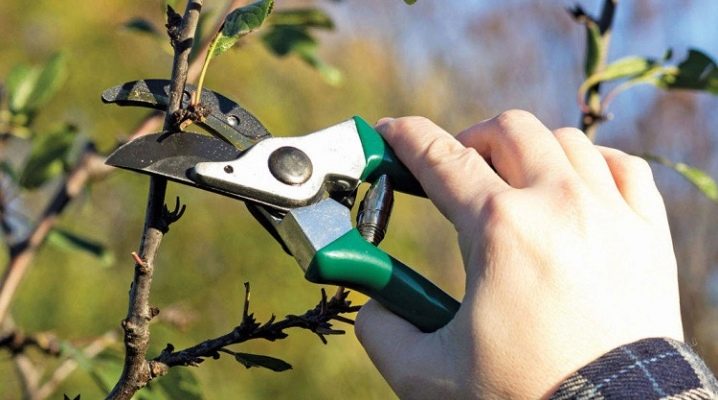
The apple tree is one of the most beloved fruit crops among gardeners; it can be found in almost every summer cottage and any personal plot. During the winter, trees experience severe frosts and attacks of starving rodents, therefore, with the arrival of spring, they need special care. The quality and volume of the future harvest largely depends on how correctly and in a timely manner all agrotechnical work will be performed.


What to do in March?
Agrotechnical work should be undertaken as soon as the average daily temperature is above zero degrees, without waiting for the snow cover to completely melt. The complex of spring procedures includes sanitary pruning, top dressing, whitewashing, treatment of damaged areas, as well as protection from insect pests and fungi.
Taking shelter
The right time to take shelter after winter depends on the climatic conditions of each particular region. The optimal temperature indicator for this is considered to be the interval from +12 to +16 degrees in the daytime. In the Moscow region, this period begins a little earlier, in Siberia, in the Urals and in the Leningrad region - later. At this time, the apple tree is dug out of the snow and opened.
To prepare the culture for a meeting with bright sunlight, it is advisable to carry out all work on a cloudy, but not rainy day. Young trees will need shading on the south side - this measure allows you to protect their delicate bark from burns and deformation. This is very important, since burns, imperceptible in the early stages, eventually lead to serious plant diseases.
It is better to free the tree from winter shelter in parts, spending 3-4 days on it. This is how a young culture gradually gets used to new external conditions.
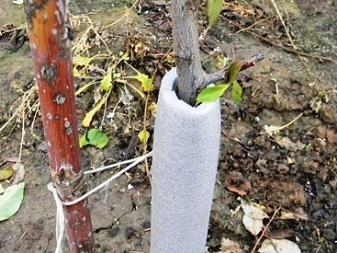
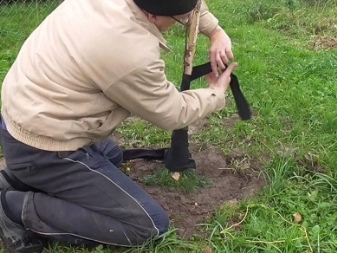
Identifying and treating injuries
In the first half of March, it is very important to inspect the branches and trunk of the tree for bark delamination and damage. In these areas, nests of insect pests can be located. Also, damage is often associated with gnawing of the tree by rodents during the winter months.
Inspection should start from the lower sections of the trunk. It will not be superfluous to clean off the old bark of the apple tree with a piece of netting, this must be done after the rain. All small damages found are treated with garden pitch or clay diluted with manure. Minor infections can be cured by applying a solution of 1 kg of salt, 2 kg of wood ash and 2 pieces of crushed soap in a bucket of water to the affected area.
Brown spots resulting from frostbite must be cut to living tissue and carefully treated with an antiseptic. If the bark peeling takes more than half the diameter of the trunk, the plant will need a bridge grafting. To do this, use native cuttings, or take material from frost-resistant varieties.
Significant damage to the culture can be caused by mosses and lichens that have appeared during the winter, they must be removed. They affect both young and old plants; the peak of activity of these organisms is observed at high humidity.
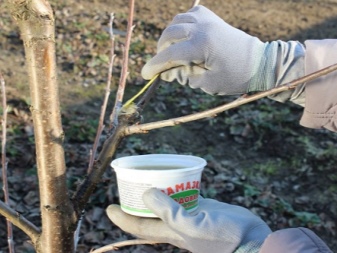
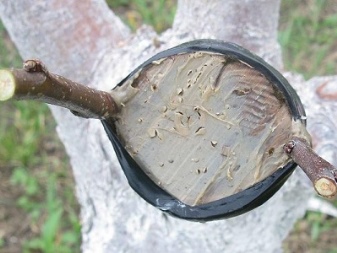
The appearance of mosses and lichens is facilitated by:
- frozen wood and sunburned wood;
- excessive crown loading;
- weakened rhizomes.
If you do not take timely measures, then the growth and development of the apple culture will slow down, the tree will be susceptible to all kinds of infections. As a result, branches die off, and a significant decrease in yield.Lichens and mosses on the bark of the apple tree block the respiratory pores of the tree, thereby creating an ideal breeding ground for insect pests.
To treat a tree, you should follow a series of simple steps.
- Examine the apple tree for sick, broken, and old branches.
- Cut out any areas heavily damaged by moss and lichen.
- Provide good permeability of air masses in the crown. To do this, you should cut off the branches in thickened areas.
If the lesion is small, then the moss can be removed manually. It is not difficult to do this - they spread polyethylene under the tree, and then carefully remove the mossy coating with a brush or wooden stick, trying not to damage the wood.
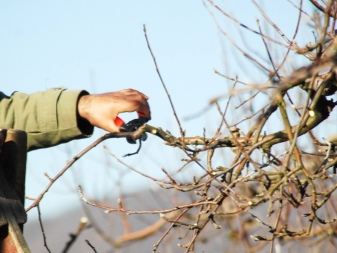
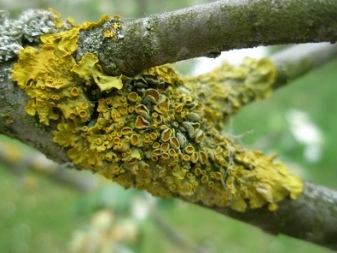
Whitewash
After completing the cleaning of the plants, you can proceed to whitewashing. Such processing creates additional protection for the trunk and skeletal branches from sudden temperature jumps at night and daytime. If this work is not carried out, cracks will inevitably appear in the bark, and this will lead to plant diseases. In addition, the whitewash provides effective protection against attacks by rodents and insect pests. And if lime-based formulations are used, they prevent the development of fungal infections.
In addition, white has the ability to reflect the sun's rays. This minimizes the risk of bark burns. Usually, spring whitewashing is washed off by rain, so the treatment is repeated at least 2-3 times. It is better to start this process from the bottom up, smoothly moving to the first skeletal branches. Special garden paints are used for processing. Alternatively, you can use chalk diluted with water to a creamy consistency. Lime is taken only for mature trees; it can cause burns on the bark of young apple trees.
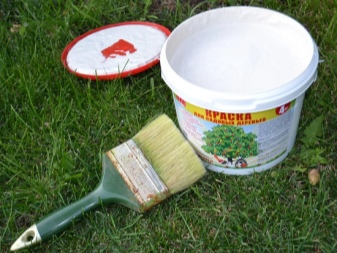
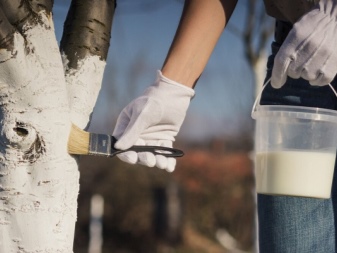
Pruning
Correctly performed spring pruning of fruit crops is an important condition for the healthy development of the apple tree and obtaining a rich harvest. Getting rid of excess branches and young shoots is very important for the rejuvenation of the fruit plant. As for young trees, this procedure helps them to form a crown. Pruning is carried out in early spring, even before the buds swell. It is impossible to carry out work in the middle of spring, when the green cone is forming.
Sanitary pruning involves the removal of all branches directed upwards - they do not give fruit, but they draw out a lot of nutrients. And also it is necessary to cut off all the shoots growing in the center, over time they cause thickening of the crown, thereby impairing fruiting. In this case, the branches that form the skeleton of the tree should be located at least 40 cm from each other. Forming pruning allows developing branches to balance and obey the main guide. In apple trees that have reached the age of 2-3 years, the competing shoot of the main conductor is completely cut out. The remaining skeletal branches are slightly shortened, adjusting them to the weakest one.
In a similar way, apple trees with a height of 5 m or more are shortened. It is best to take a hacksaw or hand pruner for this procedure. Pruning should be done in such a way that all the buds of the remaining shoot areas are directed upwards or to the outside of the crown.
In the future, you only need to monitor the growing tops, and form the correct crown - this will prevent thickening later.
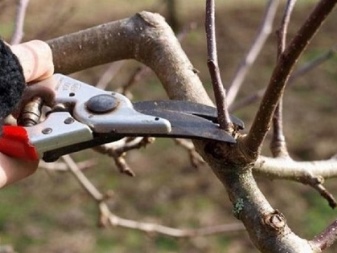
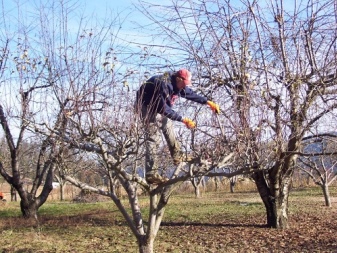
Frost protection
In spring, recurrent frosts are far from uncommon. They can cause significant damage to cut branches and a treated trunk. Therefore, it is very important to pay attention to the protection of the tree. These measures are especially relevant at the flowering stage, otherwise you should not hope for a good harvest.
You can protect the tree from recurrent frosts with water or smoke. When using the first method, on the night before the predicted frost, it is necessary to spray the crown with water from a hose with a spray, or even leave the water overnight. A thin ice crust on the surface will keep the plant warm.However, such procedures are strictly prohibited in windy conditions.
To organize a smoke screen, it is necessary to drive a stake into the ground, overlay it with peat, straw or dry leaves. Sprinkle this pile on top with slightly moistened soil. Before sunset, the stake is carefully removed and set on fire. Experienced gardeners claim that a pile 50 cm high and 1 m in diameter can save one hundred square meters of a garden from frost.
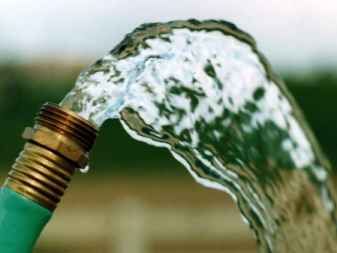

Treatment against diseases and pests
The main condition for growing a healthy apple tree is the timely treatment of the culture with agents against fungus and pest larvae. With the arrival of heat, insects become active. During this period, trap belts should be attached to the trunks so that pests cannot damage the tree.
Spraying gives a high prophylactic effect. They should be carried out at the moment when a greenish cone becomes noticeable on the kidney. Experienced gardeners recommend Fufanon fungicides, as well as Horus and Decis. They can be mixed with each other - this will simultaneously create protection against insects, bacterial and fungal infections. A good result is obtained by treating plants and the trunk circle with copper sulfate or Bordeaux liquid. It is better to spray the garden in the evening.
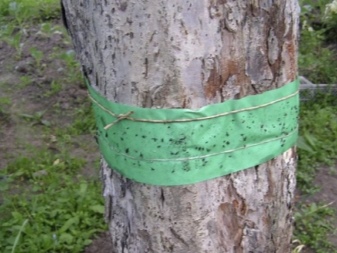
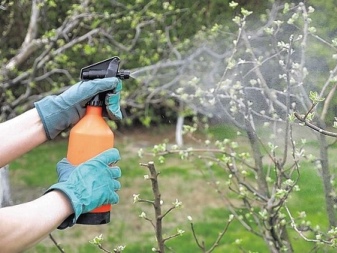
How to take care in April?
The April cares for the apple orchard are mostly related to the care of young trees. During this period, plants require watering, the introduction of nutrient dressings, loosening and mulching of the near-stem zone. Spring watering is becoming a mandatory step in apple tree care. This is especially true in the southern regions of our country, where the snow cover melts early. The useful elements dissolved in water are actively absorbed by the roots and carried to all tissues and cells of the plant. As a result, the processes of photosynthesis are activated, and the rapid blooming of leaves and buds begins.
For trees that have reached 3-5 years old, one-time watering is required at the rate of 5 buckets for each plant. For adult crops 7-12 years old, you need 2 times more water. Older fruiting plants require ample moisture. Spring watering should be done before budding. Subsequently, young trees will have to be watered 4-6 more times. As the crop grows, the amount of irrigation is reduced, but at the same time the volume of water is increased. For mature trees, a couple of waterings during the growing season will be enough.
An obligatory stage in the spring care of the garden is to loosen the soil in the peri-stem circle. This measure will enrich the substrate with oxygen. It is very important to thoroughly dig the soil around the trunk to prevent crust formation. This procedure is performed with a garden hoe, deepening it by no more than 3-4 cm. Otherwise, the roots can be damaged. It is very important to remove all weeds. They grow quickly, taking food and water for themselves. In addition, they are often inhabited by pest larvae and fungal spores. The prepared area should be covered with mulch. The greatest effect will be given by the use of humus, it is laid out to a thickness of 6-10 cm. But sawdust and sour peat should not be used. Mulching allows you to solve several problems at once - it conserves water, inhibits the growth of weeds and enhances the nutrition of fruit plantations.
In April, the plant requires the introduction of the first nutritious feeding, in total they are carried out 3-4 times during the growing season. In the last decade of the month, in the central zone of Russia, a period of active leaf growth usually begins, and in order to help the apple tree grow green mass, it needs to be fed. For this, processing is performed at the rate of 5 buckets of humus or 600-700 g of urea per adult tree.

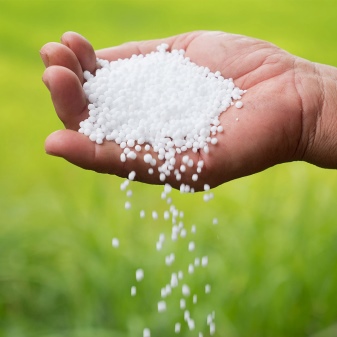
Leaving in May
With the arrival of the May heat, the apple tree needs a second feeding, it is carried out at the stage of the beginning of flowering. And also during this period, they carry out repeated chemical treatment against pests and pathogens. If an ovary is formed from each bunch, it is necessary to remove the central ovary - this will significantly improve fruiting. When the apple tree blooms, it needs re-feeding. Plants respond best to complex compounds during this period. To do this, a bucket of manure is mixed with 1 kg of superphosphate, 300 g of potassium sulfate, all this is diluted in 50 liters of water. The composition is insisted for 7 days, and watering is performed. This volume is sufficient for processing one mature tree. If you don't have organic substances at hand, you can replace them with 500 g of urea or 1 bottle of Effekton concentrate. The resulting mixture is kneaded well and left for 7 days. The nutrient solution is applied at the rate of 5 buckets for each tree in a circle at a distance of 60-70 m from the trunk.
Before and after top dressing, it is necessary to shed water near the trunk. If top dressing is dry, it will burn the roots. At the same time, another treatment for pests and infections is carried out, it is best to do this at the stage of ovary formation. At this time, highly toxic compositions are impractical, it is better to use bioactive "Fitoverm" or "Akarin". And you can also use systemic insecticides, they retain their effect for 3-4 weeks. If the plant is sick, and you use potent drugs, then the first result of their activity will be noticeable after 4 hours. Such processing is carried out twice a season. After the start of active sap flow, you can graft young trees. This will improve the quality characteristics of the crop.
Taking proper care of your apple tree in spring will lay the foundations for the healthy development of the tree. Therefore, one cannot ignore the basic rules of agricultural technology during this period. By following these recommendations, you can get a rich harvest of juicy apples.















The comment was sent successfully.